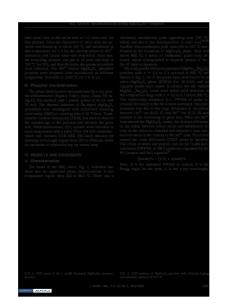Luminescence properties of newly developed red-emitting phosphors M 2 Si 2 O 7 :Eu 3+ (M=La, Y) under UV/VUV excitation
- PDF / 170,731 Bytes
- 6 Pages / 612 x 792 pts (letter) Page_size
- 51 Downloads / 278 Views
0916-DD02-06
Luminescence properties of newly developed red-emitting phosphors M2Si2O7:Eu3+ (M=La, Y) under UV/VUV excitation Zhiya Zhang, and Yuhua Wang Department of Material Science, School of Physical Science and Technology, Lanzhou University, No.222 South Tianshui Road, Lanzhou, Gansu, 730000, China, People's Republic of
ABSTRACT The red-emitting phosphors of Eu3+ doped M2Si2O7 (M=La, Y) were synthesized by a solid-state reaction method and their luminescence properties in UV-VUV region have been studied. On the excitation spectra, the Eu3+-O2- CT band is of higher intensity for La2Si2O7, while for Y2Si2O7, the absorption around 150nm is much stronger and this can be assigned to the Y3+O2- CT band in company with the Si-O group absorption. The emission spectra show higher intensity and better color purity for La2Si2O7:Eu3+ under 254nm excitation due to Eu3+ occupying the non-centrosymmetric site. Under 147nm excitation, Y2Si2O7:Eu3+ exhibits stronger emission with purer red, which can be corresponded to the absorption of Y3+-O2- CT in the VUV region.
INTRODUCTION Yttrium and the rare earth element disilicates have been extensively studied for their unique electrical, magnetic, and optical properties [1-5]. They appear in their polymorphous crystalline structures exhibiting up to seven different structures even at normal pressure, depending on the temperature and the nature of the cation [6, 7]. Among them, yttrium disilicate Y2Si2O7, shows five (or possibly six) structural forms (y, α, β, γ, δ and z) [8], and La2Si2O7 is dimorphic with a tetragonal low-temperature A form (P4122) or a monoclinic high-temperature G-form (P21/C) [9]. y-Y2Si2O7 and G-form La2Si2O7 have a similar crystal structure of monoclinic and substitution of La for Y atoms in (Y, La)2Si2O7 can occur while Si-O tetrahedra appear somewhat distorted [2, 10]. A survey has been given to the system Y2O3-SiO2, in which 1% substitution of the Ce3+ for Y3+ can result in some efficient cathode-ray with short decay time [11]. However, M2Si2O7 (M=Y, La) doped by rare earth ions as UV or VUV phosphors has not being reported up to now. It is well known that ZnSiO4:Mn is efficient commercial green phosphor and that the Si-O groups may have effective absorption of VUV photons [12]. Eu3+ can substitute for the non-centrosymmetric Y3+ or La3+ sites in M2Si2O7 (M=Y, La). So it can be expected that these phosphors would have efficient purer red emission which would overcome the poor color purity of the commercial red phosphor (Y, Gd)BO3:Eu3+. In this work, Y2Si2O7:Eu3+ and La2Si2O7:Eu3+ phosphors were prepared using a traditional solid state reaction and their photoluminescence were evaluated.
EXPERIMENT The powder polycrystalline samples, La2Si2O7:0.05Eu3+ (noted as LSO) and Y2Si2O7:0.05Eu3+ (noted as YSO) were prepared by solid-state reaction method. SiO2 (99%), La2O3 (99.9%), Y2O3 (99.99%) and Eu2O3 (99.99%) were used as raw materials with 10 mol% H3BO3 (99.5%) added as flux. The raw materials with the nominal composition were ground to fine particles be
Data Loading...











